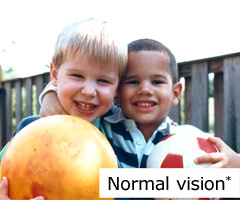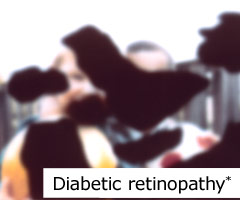Diabetic retinopathy
Diabetic retinopathy occurs when elevated sugar (glucose) levels in your blood cause the blood vessels in the eye to swell and leak in the retina. New blood vessels may also grow causing further damage. Many people who have diabetes have some form of diabetic retinopathy.
There are four stages of diabetic retinopathy, ranging from mild to severe. In the first three stages, your vision loss may not be noticeable or detected:
- Stage 1: Mild non-proliferative retinopathy - At this stage, tiny blood vessels swell in the retina. Some early leakage may take place.
- Stage 2: Moderate non-proliferative retinopathy - Some of the blood vessels that feed the retina become blocked. Leaky blood vessels are more likely.
- Stage 3: Severe non-proliferative retinopathy - More blood vessels are being blocked and other areas of the retina are not being nourished as a result. Signals are sent to the body to grow new blood vessels.
- Stage 4: Proliferative retinopathy - This is when vision loss can occur quickly. At this advanced stage, new abnormal blood vessels grow (“proliferate”) along the retina and the clear, vitreous gel inside the eye. These begin to replace old blood vessels that feed the retina. The abnormal vessels have thin fragile walls that leak easily, causing blurred vision, severe vision loss, or blindness.
The advanced stages of diabetic retinopathy can also increase your vulnerability to developing other eye conditions such as a detached retina, which requires surgery, or glaucoma.
Depending on the stage of the disease, people with diabetic retinopathy typically experience blurriness, distortion, or blind spots right in the centre of their sightline. It can also affect your ability to distinguish colours.


If you have any of the following diabetic retinopathy symptoms, see your eye doctor immediately:
- Dark spots in your visual field
- Blurred, distorted or double vision
- Large “floaters” (specks in the form of dots, circles, lines or cobwebs that move across your field of vision); they are most noticeable when looking at a white wall or clear sky; these may or may not be a sign of diabetic retinopathy, but should be checked
Diagnosis and treatment
If you have any risk factors or are experiencing any of the common symptoms for diabetic retinopathy, see an eye doctor right away. Eye doctors can check your eyes and determine if you are at risk for diabetic retinopathy using any one of six diagnostic tests: visual acuity test, dilated eye exam, tonometry, optical coherence tomography (OCT), fundus photography, and fluorescein angiogram.
Vision lost from diabetic retinopathy can't be restored, but with early detection, treatment is often very successful and can prevent your vision from getting worse.
Learn more about diabetic retinopathy by consulting with your eye doctor. Don’t have one? You can find an optometrist by clicking here or find an ophthalmologist by clicking here.
